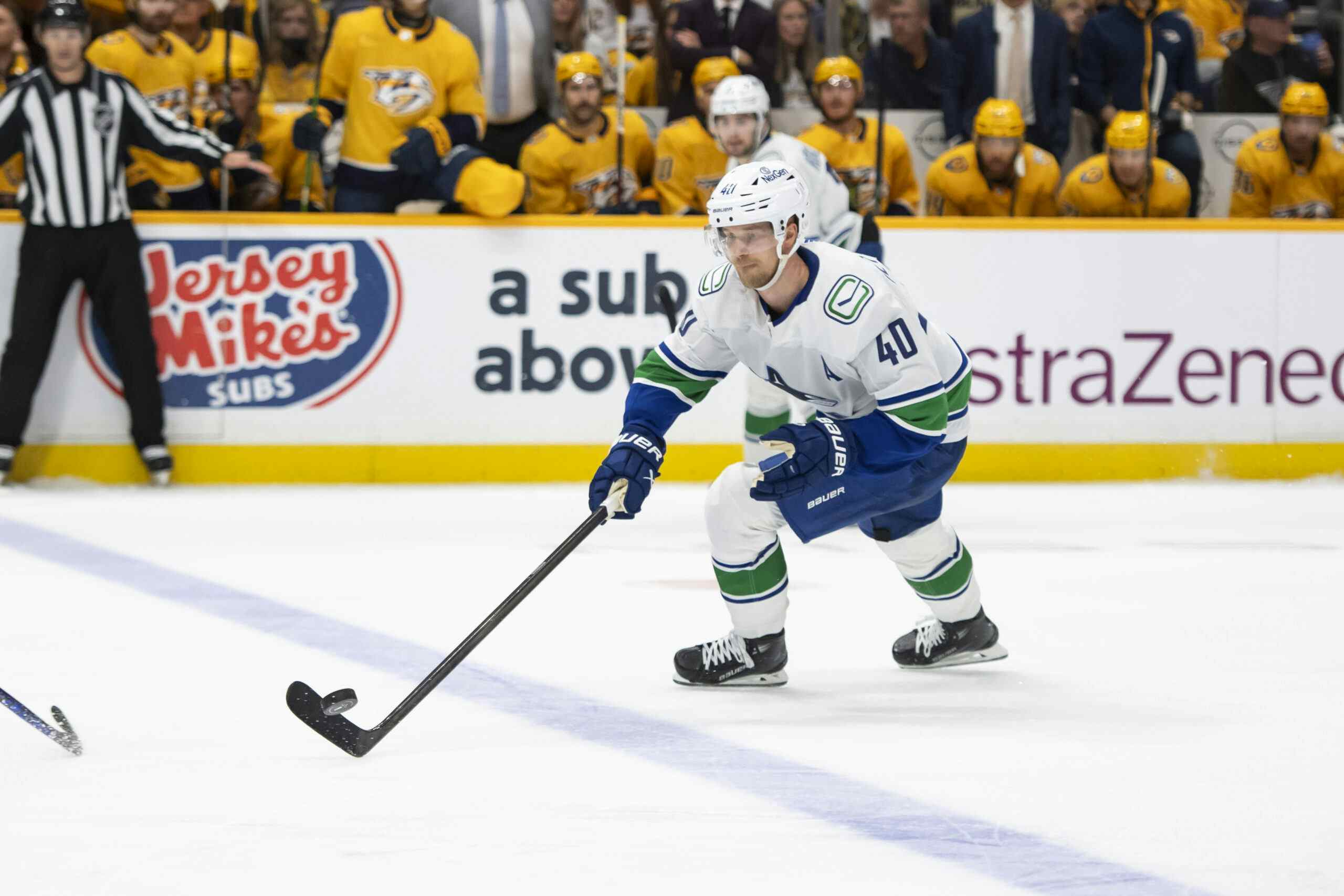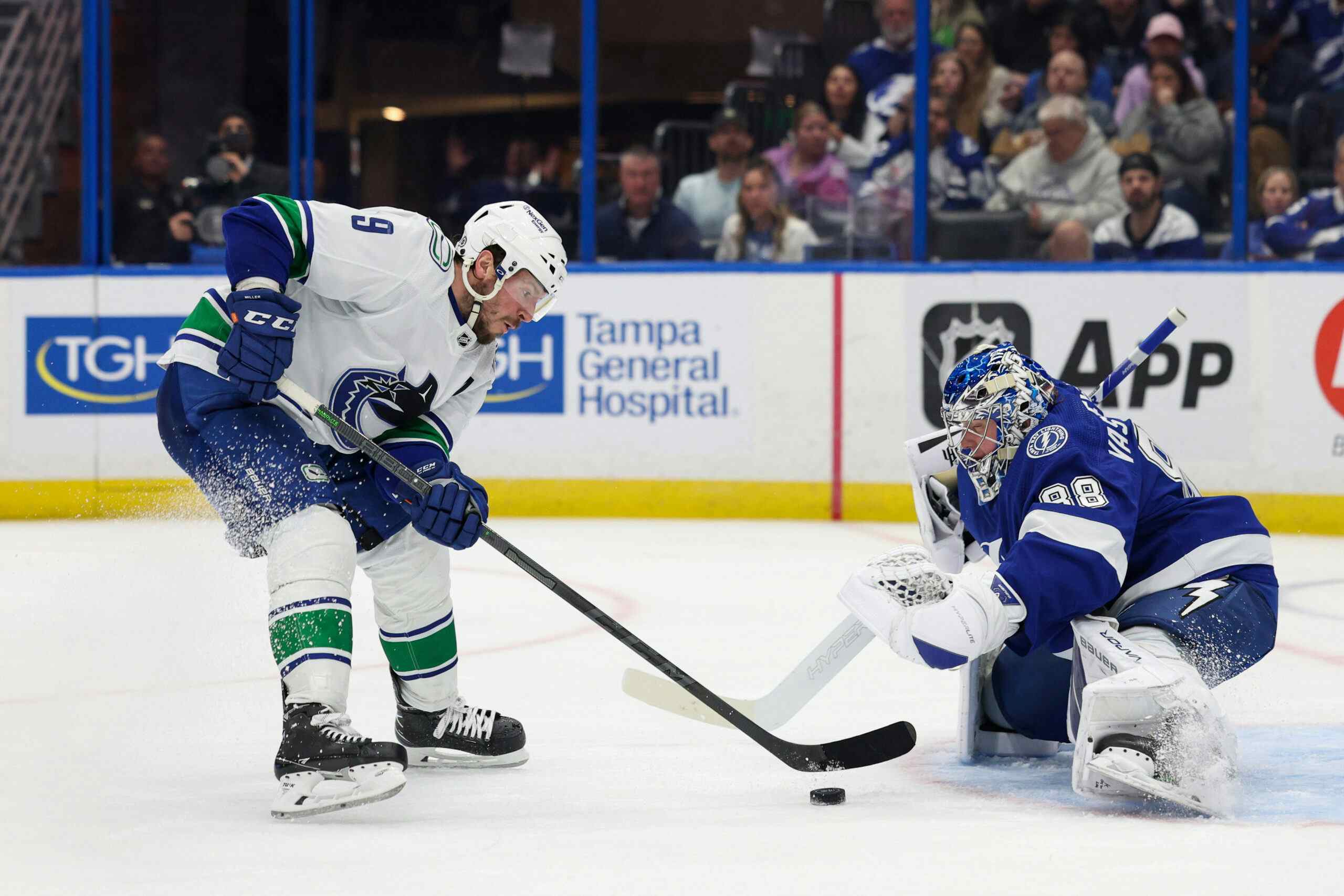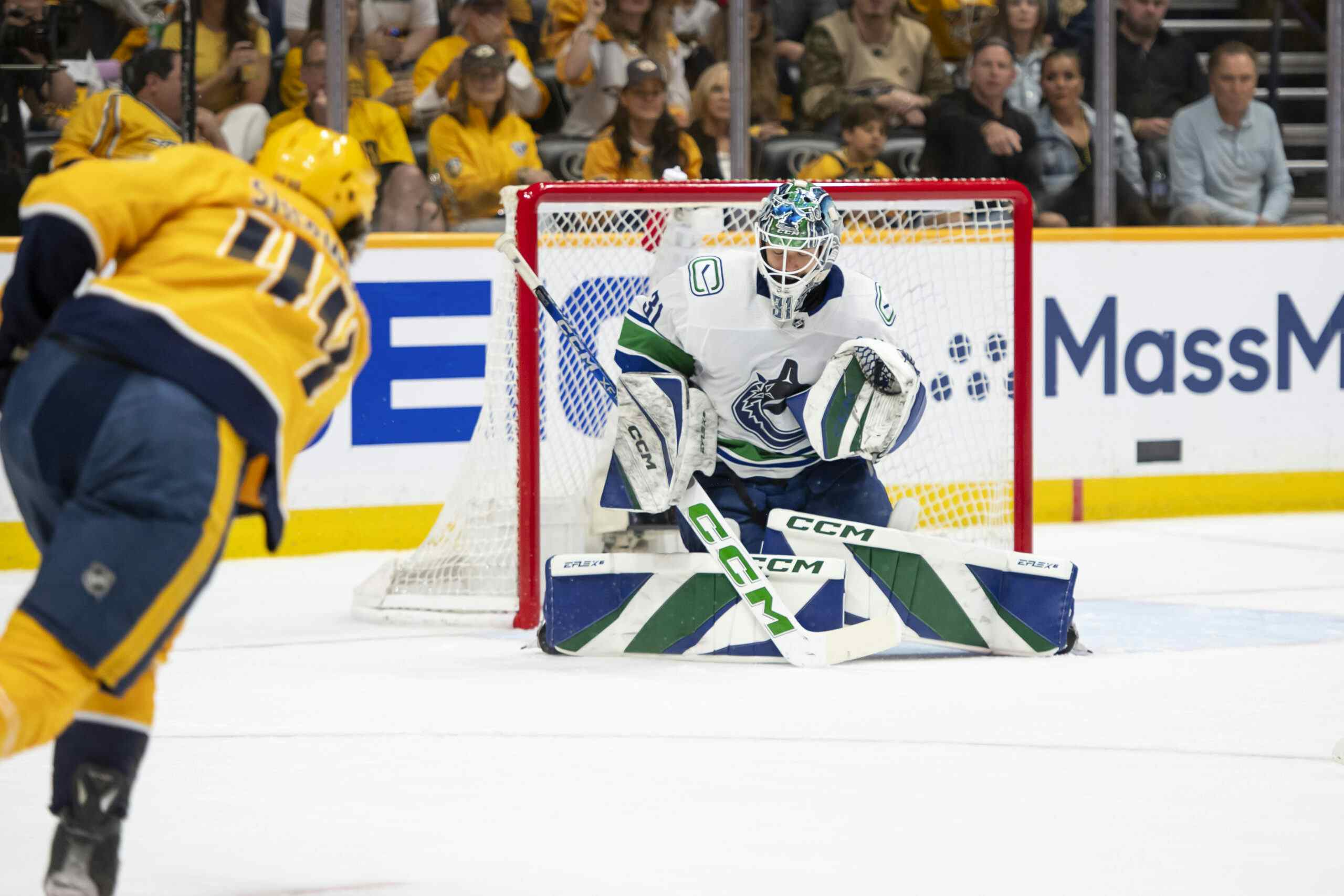We Were Wrong About Bo Horvat
7 years ago
For a player that’s been under the magnifying glass since the age of 16, Horvat remains somewhat of an enigma. His bull-rushes and inside-outside moves have enthralled Vancouverites over the past two years, as he’s firmly planted himself in fan favourite territory, but there still seems to be little consensus on just what exactly the Canucks have in the young centreman.
It’s pretty clear at this point that the Canucks landed an impact forward when they selected Horvat with their first-round pick in 2013, but over three years later there remains some debate about what his ceiling is, what role he’s best suited for, and even what his strengths and weaknesses are.
Back in the summer of his draft year, Horvat was lauded for his two-way game, and specifically his play without the puck. Many figures in the blogosphere saw Horvat as a decidedly old-school player to select at 9th overall, as evidenced by the accolades he received from scouts at the time of the 2013 draft.
Sportsnet:
“Horvat is a wizard in the faceoff circle and a reliable defensive player. He plays a refined defensive game and worked well in the Knights’ trapping system. Horvat has an active stick that he uses to break up passing lanes and pickpocket the opposition in the neutral zone.”
Mckeen’s:
A smart, consummate team player who plays a solid and consistent two-way game .. trusted by the coaching staff and used in all situations .. excels at face-offs .. makes responsible plays, exploiting an above-average skill set .. routinely matches up against the opposition’s best players which factors in blunting his plus-minus totals.
Brendan Ross, Dobber Prospects:
This future captain of an NHL team owns a complete package of skills and the intangibles of no other player in this draft class. Understanding and reading the game is Horvat’s greatest asset and it is evident in his ability to play in all three zones of the ice … He lacks top end speed but his powerful skating stride makes him a difficult player to knock off the puck especially when he combines his underrated puck control skills and intense never-quit attitude in board battles.
At the time of his selection, Horvat looked like a good bet to make the NHL, but there were concerns about his ability to produce offence. Horvat failed to reach the point-per-game plateau in his draft year, and even after exploding to 74 points in 54 games in his draft+1 season, he never finished higher than 3rd in team scoring. There was also some concern that Horvat was benefiting from linemate Max Domi, an elite producer of offence at the OHL level. Needless to say, in spite of the accolades he’d received from scouts, Bo Horvat wasn’t without his detractors.
One such detractor was former Canucks Army Managing Editor Rhys Jessop, who penned an infamous post in the spring of 2014 entitled, “Reasonable Expectations For The Future: Is Bo Horvat A Top-6 C?”
Bo Horvat will, by all accounts, be an NHL player. He’s a very good CHL’er and possesses a skill set that is fawned over by NHL GMs. When prognosticating these sorts of things, though, we need to evaluate what the most likely outcome is moving forward. For Horvat, the most likely route his career takes sees him topping out as a decent 3rd line C, scoring in the mid-40s in points just once or twice, and finishing his career having played for 4 or 5 different teams. Even then, he probably won’t be ready to step into that 3rd line role and be effective for another 3-4 years after this one. Nothing he’s done in junior screams “I’m ready” for full-time NHL duty, and most players spend significant time apprenticing in the AHL anyways.
There isn’t really a reason to conclude that Horvat is better than “most players,” so thrusting him into the spotlight and asking him to anchor the 3rd line on a team that wants to be going places isn’t really a reasonable expectation at this point in his career.
All in all, Bo Horvat simply is not a player you build your future around, and is certainly not a player you draft with the 9th overall pick when there are players available that are clearly better bets to become impact pros – players like Valeri Nichushkin and Max Domi, and to a lesser extent guys like Josh Morrissey, Alex Wennberg, Nic Petan and Hunter Shinkaruk (thank god he fell to 24th). He’s a guy you should feel comfortable taking in the 2nd or 3rd round, as coaches will always give him a second look since he does the defensive stuff well. He more than likely won’t make an impact in the next few seasons though.
Hindsight is a funny thing. At the time, Rhys’ analysis appeared entirely reasonable. Based on what we now know about draft analytics, there were legitimate reasons for Horvat’s selection to raise eyebrows. His pGPS% of 27% was on the low side for what we’d expect from a 9th overall pick, and Horvat’s successful matches averaged roughly .36 points per game. Even after he exploded in his d+1 year, those numbers only increased to 39% and .41 respectively, still low for a top-10 selection.
Hockey is a results-based business, though, and the article has since become a bit of a smoking gun for folks online to point to as evidence of CA’s perceived lack of skill when it comes to evaluating prospects. To some degree, that’s fair. Horvat’s already surpassed what we expected from him based on his statistical profile.
Since entering the league in 2014-15, Horvat has produced at a rate of 1.6 P/60 minutes, which is good for 7th among Canucks with over 500 minutes of ice-time over that period of time, just behind Radim Vrbata. His goal generation has been even more impressive, finishing behind only Shawn Matthias, Nick Bonino, Sven Beartschi, and Jannik Hansen in that sample. For context, Horvat’s G/60 rate of 0.79 is just behind Johnny Gaudreau’s 0.8 and slightly ahead of teammate Daniel Sedin’s mark of 0.74. He’s in very good company.

It seems likely at this point that he’s capable of better things offensively than we ever gave him credit for. We were wrong about Bo Horvat. But no, I don’t just mean Canucks Army, I mean everybody.
For a player that was lauded so much for his two-way ability, the defensive aspect of his game hasn’t really developed at the rate scouts believed it would back when Horvat was drafted. Among forwards with over 500 minutes of ice-time since 2014-15, Bo Horvat has been among the most porous defensively, ranking in the bottom 50 in Corsi and Fenwick against per 60, and ranking in the bottom 5 in goals allowed per 60.
Now obviously, it’s still early in Bo’s career, and there’s plenty of time for both peaks and valleys in his development, but thus far, the defensive side to his game is still leaving a bit to be desired. I don’t think it’s too early to draw conclusions, either. Even if you’re convinced quality of competition has a tangible effect on player performance, there’s no evidence to suggest that the quality of competition Horvat has faced is significantly above that of his peers, and there’s reason to believe it’s not just inexperience that’s driving his inability to suppress shot attempts, either.
Back in January, Rhys’ published an article on his personal blog that looked at every forward that played over 400 minutes in their age-20 year since 2010 and compared them to Horvat using Dominic Galamini’s WARRIOR charts. Surprisingly, most of Horvat’s peers that are known for their defensive play already showed significant aptitude for shot suppression by their age-20 season.
Now, remember that this is a cursory glance more than anything, but I think it’s fair to say that Horvat’s behind the curve of where you want him to be, especially if you’re holding out hope for a Ryan O’Reilly type player in two or three years’ time. I also don’t think you can wash out teammate effects from these charts, but we also don’t really have much evidence that Horvat’s average quality of teammate is much different from the majority of this group either…
[it’s] pretty easy to have confidence his raw talent level is above the numbers he’s produced. On a personal note, I think Horvat’s numbers should improve by the end of the season, and he should start moving towards mid-range 3rd line offensive levels at the very least. I’d also expect his CA/60 numbers relative to the rest of the Canucks to not remain in the gutter. Basically, I see no reason he shouldn’t resemble Mark Scheifele or Sean Monahan by the time this season is done.
With all that said, even at just 20 years old, Horvat’s likely running late on catching the O’Reilly/Staal two-way ace train. He’s got a lot of ground to cover in a pretty short time if he’s going to catch up.
Out of the 54 players in Horvat’s age and TOI-based cohort, only five bled shot attempts at sub-replacement-level: Andrew Cogliano, Marcus Johanssen, Brandon McMillan, Steven Stamkos, Brandon Sutter. (Nathan MacKinnon and Chris Tierney just barely missed the cut.) There are some good players in there, but it’s not exactly a list of two-way aces.
All this isn’t to say that Horvat can’t improve. He almost certainly will. It just may be time to re-examine how we think about Horvat and the type of player he is. He’s still young and I’d wager his defensive numbers improve over the next few seasons. With all that said, however, I’d think the ship has sailed on Bo Horvat being an elite shot suppressing forward. A jump from replacement-level to first line calibre CA/60 isn’t impossible, but it is highly, highly unlikely.
This brings us to the question of deployment, and whether or not the Canucks are doing everything they can to get the most out of Horvat. Thus far, I’d say they haven’t. Sven Baertschi has struggled to produce offence through the first eight games of the season but looks poised to break out. Can’t say the same for the revolving door of right wingers that line has seen so far, though. If you’re looking for offence, I’m not sure alternating between Jack Skille, Jake Virtanen, and Derek Dorsett is the best route to go. I’ve been banging this drum for awhile, but I’d really like to see Loui Eriksson get an extended look on that line, especially since he hasn’t exactly shot the lights out playing alongside Henrik and Daniel Sedin.
It’s not as though Horvat has been deployed in manner consistent with a goal-scorer, either. Under Willie Desjardins, only Emerson Etem started a higher percentage of shifts in the defensive zone. The relationship between zone starts and goals for and against is vastly overestimated, but burying Horvat in his own end likely isn’t helping. Going forward, the Canucks may want to examine their perception of Horvat and whether they’re better suited lightening his defensive load and placing more of the responsibility on Brandon Sutter –something we’ve advocated basically from day one.
Horvat may be a different player than the one we were expecting, but overall I’d say the way he’s developed is pretty encouraging. He just may be more one-dimensional than we originally anticipated.





